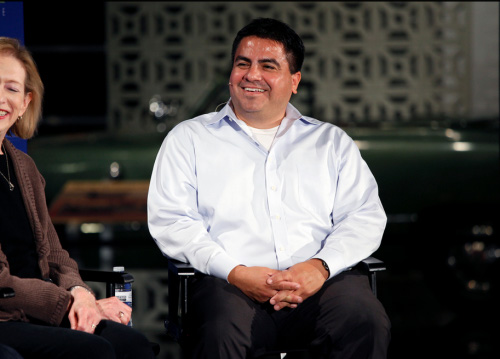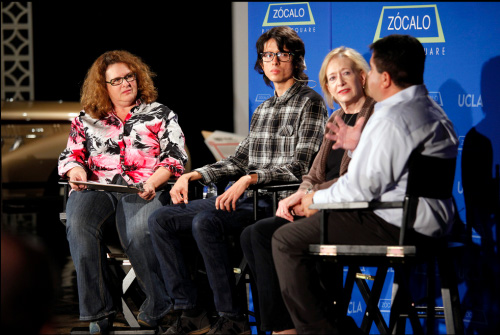Zocalo Public Square: Alex Ortega: How Angelenos Eat Now
How Angelenos Eat Now
This Is a City With Astonishing Food Options. How Can We Make the Healthier Ones Pull Ahead?
BY SARAH ROTHBARD|NOVEMBER 19, 2013
Los Angeles, explained KCRW Good Food host Evan Kleiman, is a city of two food worlds that collide at the Grand Central Market downtown. For not a lot of money, communities of color have shopped at the Grand Central Market for produce or quick meals. Now, it’s becoming gentrified, Kleiman said. “New food is infecting it.”

Kleiman was moderating a panel about the dietary life of Angelenos, a “Thinking L.A.” event co-presented by UCLA. The setting, which had a large crowd, was the Petersen Automotive Museum. In opening up the discussion about the state of L.A.’s plate, Kleiman asked a panel of people who look at food from different angles how these two food worlds, richer and poorer, can interact a little more. A million people—many of them children—go to bed hungry in L.A. every day. Yet obesity is also a huge problem. What’s being done about both of these issues?
UCLA Center for Population Health and Health Disparities epidemiologist Alex Ortega said he is trying to figure out what it takes to improve food choices in what he called L.A.’s “food swamps”—low-income neighborhoods with many fast food restaurants but few venues offering healthy foods like fruits and vegetables.
Ortega has found that it’s hard to get kids to eat healthy food anywhere, but in the neighborhoods where he works—East L.A., Boyle Heights, South L.A., and parts of Long Beach—framing the issue as one of food justice and inequality is highly effective. The kids know what foods are healthy, so “it’s more about reframing the issue to get kids motivated” rather than simply telling them to eat their fruits and vegetables, he said.
Ortega and his colleagues also are working to convert corner stores—where families do some shopping and where kids go for snacks before and after school—into “healthy assets” for their communities.
“The Glutster” Javier Cabral, a food writer who grew up in East L.A., said that it’s not the responsibility of the store owners to change people’s eating habits. They know their role in the community, he said, “but at the end of the day they’re selling what their customers want to buy, and these kids want to buy Flamin’ Hot Cheetos and a Coke.” Also, he said, families do most of their shopping at the grocery store, relying on corner stores more for last-minute purchases.
The intervention isn’t just “if you build it, they will come,” said Ortega. It’s also about serious social marketing—health education. The idea of changing these stores is that the impact will be felt in the entire neighborhood, just as the goal in educating students is to have an impact on their families and neighbors and friends.
Kleiman asked Ortega and Cabral if families in East L.A. tend to cook from scratch or if they use the same convenience products that much of America relies on.
Ortega said it depends in part on whether there’s someone at home who doesn’t work. But Cabral said that in his experience, it’s so much cheaper to cook than to go out, even for fast food, that most families have to cook at home. He admitted, however, that in his first years in high school he’d eat a Burger King double cheeseburger most afternoons, simply because it cost just 99 cents.
Cabral credits food writer Jonathan Gold with converting him into an adventurous eater—one who would seek out a falafel joint 10 blocks from school at lunchtime. But that made Cabral unusual, of course. What, asked Kleiman, can be done to break down the lack of curiosity in so many kids about new foods?
Former Bon Appetit editor Barbara Fairchild said that her curiosity came from growing up in a “food household” where she was encouraged to try everything. It also helps for kids to have a natural interest in trying new things. And although Cabral pointed out that most good food costs more money than what kids want to spend, Fairchild said that it doesn’t have to.
Ortega said that a lot of efforts to get people to eat more healthfully—like labeling menu items with calories—are laudable. But it’s difficult to determine whether they have an impact on the population they want to help. At a Dunkin’ Donuts he frequented in Philadelphia, for instance, he asked the woman behind the counter if anybody paid attention to the calorie counts listed on the menu. “‘Only those who ask for Splenda,’” he was told.
Kleiman said that menu boards have made a difference; independent restaurant chefs in L.A. who label the sources of the produce on their menus have started a new conversation about where our food is coming from. At the same time, she said, most people aren’t asking about where the meat their taco trucks serve is coming from.
The same people who idolize a taco truck that may be serving genetically modified tortillas and low-quality meat are the same people who idolize produce from a certain farm, said Cabral. Why do they turn a blind eye depending on the context?
Fairchild pointed to food world “schizophrenia.” For all the media buzz around healthy eating, the Food Network—which is where most people are learning about cooking—is only promoting its own personalities.
But Ortega said that in low-income communities, the media is less of an issue than education. Physical and health education programs in our public schools are failing, he said.
Kleiman said that Los Angeles chef Roy Choi, best known for his Kogi Korean barbecue trucks, created a stir at a culinary conference in Copenhagen by suggesting that chefs could do more for low-income communities. He said that every chef who is backed by an investment group should open a business in an underserved community whenever they open a new high-end restaurant.
Ortega cautioned that opening in a new neighborhood, simply changing a menu, or hiring people from a community won’t bring in foot traffic. People go to restaurants for an experience—not just to eat salads.
Healthy eating, countered Kleiman, doesn’t have to mean a salad.
But, said Ortega, getting people to think about food in a different way remains easier in some communities than in others.
The speakers addressed that issue in the question-and-answer session, in response to an audience member commenting on a recent trip to a packed Red Lobster restaurant in L.A.
We have proximity to excellence, said Kleiman—but we don’t always choose to use it. Olive Garden, Cheesecake Factory, Red Lobster—in L.A., where we have everything, they’re packed all the time, said Fairchild. Some communities, said Ortega, cannot choose. And that disparity is what makes L.A. unique. But even when presented with choices, people will make the decisions they’re going to make: Cabral said that at the Boyle Heights and East L.A. farmers markets, kids are buying cupcakes.
“We have to start somewhere,” said Kleiman. What other major urban area has over 80 farmers markets in the course of a week? They may fall short of the quality of the beloved, nationally renowned Santa Monica market, but they’re there.
Thinking L.A. is a partnership of UCLA and Zócalo Public Square.
EDITOR: T.A. FRANK.
*PHOTOS BY AARON SALCIDO.

